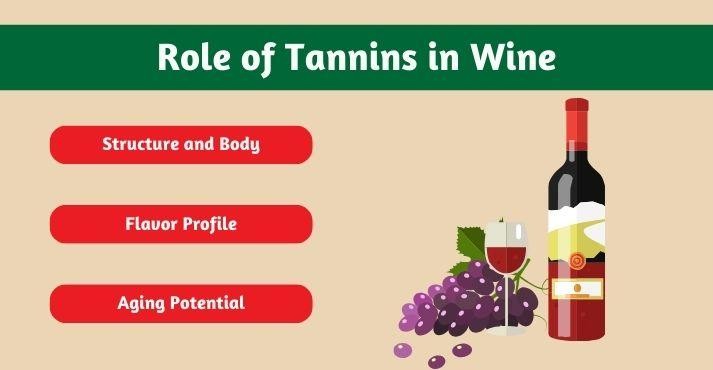Have you ever wondered why some wines feel dry or astringent on your palate? That sensation often comes from tannins, a natural compound that plays a crucial role in shaping the flavor and structure of wine.
For wine enthusiasts, sommeliers, and restaurateurs, understanding tannins in wine is essential to appreciating and pairing wines effectively.
Tannins not only influence a wine’s taste but also determine its texture, body, and aging potential. From bold, high-tannin wines like Nebbiolo to low-tannin wines like Pinot Noir, the presence of tannins defines the diversity and complexity of wine.
In this guide, we’ll explore what are wine tannins, their sources, and how they boost the sensory experience of wine.
What Are Tannins?
Tannins are natural compounds found in plants, playing a vital role in wine’s taste and structure. Chemically, tannins are polyphenols, a class of antioxidants that contribute to the drying, puckering sensation often associated with red wines.
Tannins are most concentrated in grape skins, seeds, and stems, which are integral to winemaking. During fermentation, these elements release tannins into the wine, imparting texture and astringency. They’re also introduced through oak barrels used in aging, adding complexity to the wine.
Tannins’ defining characteristic is the drying sensation they create on the palate. This occurs because tannins bind with proteins in saliva, reducing lubrication and leaving a rough, dry feeling. While some may find this sensation intense, it’s what gives wines their structure and body, particularly in bold reds.
Sources of Tannins in Wine
The sources of tannins in wine are primarily natural, derived from both the grapes and the winemaking process. These include:
- Grape Skins: The thicker the grape skin, the higher the tannin levels.
- Seeds and Stems Often contribute to bitterness when pressed during fermentation.
- Oak Barrels: Aging in oak adds tannins, enhancing texture and complexity in wines like Chardonnay or Cabernet Sauvignon.
Role of Tannins in Wine

Tannins serve as the backbone of wine, playing a vital role in defining its structure, flavor, and aging potential. These naturally occurring compounds are essential to crafting wines that are balanced, complex, and enjoyable across a wide range of styles.
From bold reds to subtle whites, tannins contribute to a wine’s character and boost its sensory appeal. Let’s explore how tannins influence the key attributes of wine.
1. Structure and Body
Tannins are integral to the structure and body of wine, providing the framework that supports its other components, such as acidity and sweetness.
This framework creates a balanced texture that improves the wine’s overall mouthfeel. Without tannins, wines would feel flat and lack the robust texture that defines their character.
For instance, in a bold red like Cabernet Sauvignon, tannins play a prominent role, contributing to its full-bodied and well-rounded structure. This makes it a favorite for those who enjoy wines with depth and complexity.
The tannins in Cabernet Sauvignon give it a firm grip on the palate, which pairs well with rich, fatty dishes like steak or lamb.
In contrast, low-tannin wines such as Pinot Noir offer a softer, smoother mouthfeel. Pinot Noir’s delicate tannin structure makes it an excellent choice for those who prefer lighter wines that are easier to drink.
This balance of structure and softness highlights how tannin levels influence the wine’s body and appeal to different preferences.
The tactile sensation created by tannins, often described as drying or astringent, also contributes to the wine’s mouthfeel, adding layers of complexity that make tasting wine a richer experience.
2. Flavor Profile
Tannins play a critical role in shaping a wine’s flavor profile, particularly through their astringency and bitterness. These characteristics contribute to the wine’s boldness and intensity, especially in red wines.
For example, Nebbiolo, a high-tannin variety, is known for its pronounced astringency and complex flavor notes of cherry, tar, and rose. The high tannin levels in Nebbiolo create a puckering sensation on the palate, which is balanced by its vibrant acidity and nuanced aromas.
This bold tannin taste is what makes Nebbiolo wines like Barolo or Barbaresco legendary for their powerful and sophisticated profiles.
On the other hand, medium-tannin wines such as Merlot strike a harmonious balance, offering a smoother experience with just enough tannin to provide structure and depth.
The tannins in Merlot contribute to its soft, velvety texture, developing flavors of plum, chocolate, and herbs without overwhelming the palate.
While tannins are a defining feature of red wines, excessive tannin levels can sometimes dominate the flavor, leading to a harsh or bitter experience.
Winemakers carefully manage tannin levels during production to ensure that the wine’s astringency complements, rather than overshadows, its flavor. This balance is crucial to crafting wines that are both complex and approachable.
3. Aging Potential
Tannins are natural preservatives that play a pivotal role in a wine’s ability to age gracefully over time. During the aging process, tannins undergo chemical changes that soften their texture and integrate with the wine’s flavors, resulting in a smoother, more harmonious profile.
For example, a young Bordeaux wine may initially taste sharp and tannic upon release, with prominent notes of blackcurrant, cedar, and graphite.
However, after a decade or more of aging, the tannins in the Bordeaux soften, allowing secondary and tertiary flavors like leather, tobacco, and earth to emerge. This transformation makes the wine more refined and complex, increasing its enjoyment.
Wines with strong tannin levels, such as Cabernet Sauvignon, Nebbiolo, or Tannat, often have greater aging potential compared to lighter, low-tannin wines. This is because the tannins act as antioxidants, protecting the wine from spoilage and oxidation over time.
On the flip side, wines with lower tannin levels, such as Pinot Noir or Gamay, are typically enjoyed young. These wines lack the structural support that tannins provide, making them less suitable for long-term aging but perfect for immediate consumption.
Tannin Levels in Popular Wines

Not all wines have the same tannin levels, and this difference plays a crucial role in determining their texture, flavor, and pairing potential. You can enjoy bold, structured reds or prefer softer, smoother options; knowing tannin levels can help you choose wines that suit your taste and occasion.
High-Tannin Wines
High-tannin wines are bold, structured, and known for their pronounced astringency and aging potential. These wines often have a firm grip on the palate, making them excellent for pairing with rich, fatty foods that balance their intensity.
- Nebbiolo: Famous for its high tannin content, Nebbiolo wines like Barolo and Barbaresco deliver intense astringency, complex flavors of cherry and rose, and remarkable aging potential.
- Cabernet Sauvignon: A classic red wine with a firm tannin structure and bold notes of blackcurrant and cedar, ideal for long-term aging.
- Tannat: Robust and tannic, Tannat offers deep, earthy flavors and exceptional structure.
Medium-Tannin Wines
Medium-tannin wines strike a balance between structure and smoothness, offering versatility and approachability.
- Merlot: Known for its soft, velvety texture, Merlot combines moderate astringency with flavors of plum, chocolate, and herbs.
- Malbec: Rich and fruity, Malbec features balanced tannins that complement its vibrant blackberry and spice notes.
Low-Tannin Wines
Low-tannin wines are lighter, smoother, and more approachable, catering to those who prefer less astringency.
- Pinot Noir: A delicate red wine with soft tannins and subtle flavors of cherry and earth, making it a versatile choice.
- Gamay: Fresh and fruity, Gamay is perfect for casual occasions or those new to red wines.
Frequently Asked Questions (FAQs)
Are tannins bad?
No, tannins are not sour. They are natural compounds that boost the flavor, texture, and aging potential of wine.
Why does red wine have more tannins than white wine?
Red wines have more tannins because they are fermented with grape skins, seeds, and stems, which release tannins. White wines are typically made without prolonged skin contact.
Does white wine have tannins?
Yes, but in much lower quantities. White wines may gain tannins through oak barrel aging rather than skin contact.
Do all wines have tannins?
Yes, all wines have tannins, but the levels vary. Red wines are more tannic due to fermentation with grape skins, while white wines typically have minimal tannins.
Conclusion
Tannins are an essential element of wine, shaping its flavor, structure, and aging potential. When comprehending wine tannins and their role in the winemaking process, consumers can better appreciate the diversity and complexity of wines.
From the bold structure of red wine tannins to the subtle presence in whites, tannins contribute to the unique character of every bottle.
You prefer bold, high-tannin wines or smooth, low-tannin wines; understanding wine tannins enriches the wine experience, allowing for more informed selections and perfect pairings.





























